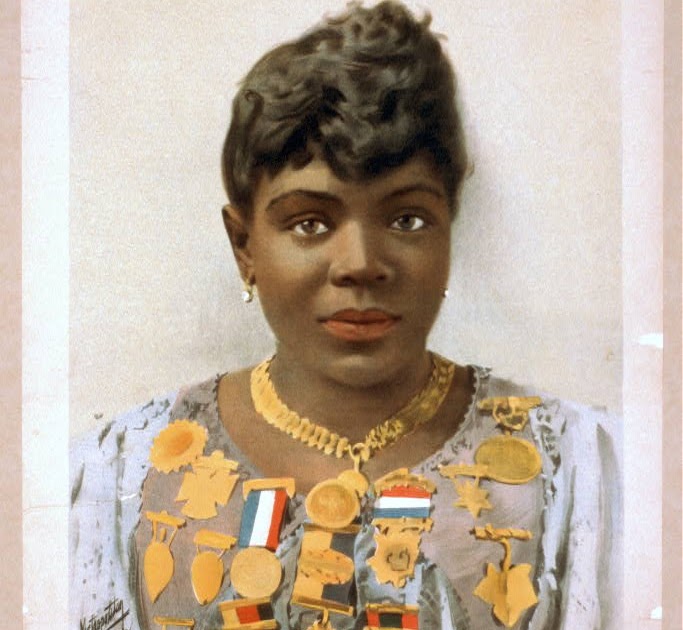Matilda Sissieretta Joyner Jones (January 5, 1868 or 1869 – June 24, 1933) was born in Portsmouth, VA, and grew up in Providence, Rhode Island.
Some of the world’s most credible critics called her “The First Negro Prima Donna.” In reality, she was the successor of the real first Black prima donna, Elizabeth Taylor Greenfield (1809-1876), a native of Natchez, MS who achieved her most enduring fame as the “The Black Swan”. She has also been called Americas first black pop star.
If anything, Greenfield was certainly America’s first Black prima donna, at the very top of a growing ledger of Black prima donnas, including the still living Leontyne Price, a native of Laurel, MS.
THE BLACK SWAN
The New York Metropolitan Opera House was not built until 1883, seven years after the death of Elizabeth Taylor Greenfield, so she suffered no bans from the Met. She had sung instead at the most famous concert halls of her time, the same venues that accommodated the Swedish Nightingale, Jenny Lind, and the European prima donna foremothers of Adelina Patti, the “White Patti,” whose name was imposed on Sissieretta Jones, unwillingly at first, though Jones came to live with the moniker as it made her rich and famous over time.
It was almost a given that Elizabeth Taylor Greenfield, considered to be a “Negro freak” by some of her white contemporaries, would be labeled something akin to the very white Swedish Nightingale – the Black Swam versus the Swedish Nightingale – though not for any good reason.
Greenfield embraced the stage name of the Black Swan, a name somewhat noble and very impressive on the surface. She gave a command performance for Queen Victoria at Buckingham Palace on May 10,1854, the first African American to perform before British royalty. Famous novelist Harriet Beecher Stowe accompanied Greenfield on some of her musical travels.
In 1921, musician and music publisher Harry Pace named the nation’s first successful Black-owned record company Black Swan Records in her honor. William Grant Still was the musical director of Black Swan Records.
BLACK PATTI
Sissieretta Jones did not like the nickname “The Black Patti,” but she realized the ticket buyers were the gods of the marketplace and so she succumbed to their demands. During the latter part of her career, she formed the Black Patti Troubadours who toured on several continents and made a lot of money while having the time of their lives.
Black Patti’s namesake, Adelina Patti (1843 – 1919) was born in Spain to Italian parents. Her family moved to New York when Adelina was still a young child. Patti grew up in the Wakefield section of the Bronx, where her family home remains.
The White Patti first sang in public as a child in 1851 and gave her last performance before an audience in 1914. At the height of her career, she was the highest paid performer in Europe or America, commanding such huge fees for her performances that she was able to retire in luxury.
SISSIERETTA JONES
The highly talented Sissieretta Jones was no fluke, no child of nature just waiting for some genie to come along and release her from his magic bottle.
Her mother, Henrietta, was a talented pianist and vocalist, having played piano and sung in the Providence, Rhode Island, Ebenezer Baptist Church until her death. The young Matilda “showed possibilities as a singer and would fill the air with melody on the slightest provocation,” one observer said.
Henrietta was a single parent for a number of years after the family’s move to Providence. Most likely, she was the young Matilda’s first piano and voice coach. Matilda’s first lessons outside her home came when she was a teenager.
Matilda married David Richard Jones in 1883 when she was 14 and gave birth to a girl, Mabel, on April 8, 1884. Mabel only lived for two years.
By 1884, Matilda’s father had moved to a house at 8 Grave’s Lane in Providence. Her mother lived at 7 Jackson Court, and Matilda Jones is listed as a boarder there. Matilda’s musical studies during this time are not revealed. Her mother, Henrietta, probably took care of little Mabel during those times when Matilda had to practice or take her lessons, her biographer speculates.
“She commenced her instrumental education at the age of 15 at the Providence, R. I., Academy of Music, under the tutelage of the famous vocalist Baroness Lacombe, an eminent Italian preceptor, and her husband, a Mr. Monros, also eminent in the world of music,” wrote her biographer John Graziano.
She also enrolled in the Boston Conservatory Music School at age 18 and had vocal training at the Conservatorium at Boston, Graziano said.
“No record of her attendance survives at the New England Conservatory, and it is possible that she was not registered there, but instead studied privately with a member of the faculty,” Graziano says. “It may also be that she studied at a different music school, perhaps the Boston Conservatory of Music.”
MUSIC CAREER
Her professional career took off slowly, but steadily. She was featured as the opening act for a production of Shakespeare’s Richard III in Providence on Oct. 29, 1885. In 1887, she performed before an audience of 5,000 at Boston’s Music Hall. Her debut at New York City’s Steinway Hall followed on April 5, 1888.
Around this time a critic at the theatrical journal The New York Clipper dubbed her “the Black Patti” after Adelina Patti, an epithet that Jones disliked, preferring instead to be called “Madame Jones.”
She later told a reporter that the name “rather annoys me… I am afraid people will think I consider myself the equal to Patti herself. I assure you I don’t think so, but I have a voice and I am striving to win the favor of the public by honest merit and hard work.”
James R. Smith, Adelina Patti’s agent and part-owner of a company of touring singers – the Tennessee Jubilee Singers – who modeled themselves after the Fisk Jubilee Singers, contracted with Jones to sign on for a two-year tour of the West Indies, the Windward Islands, and South America. Jones, now 20 years old, would be promoted as the prima donna of the ensemble.
Smith intended, without a doubt, to play on the reputation of the real Fisk Jubilee Singers to promote his company. While he never said outright that his troupe was from Fisk University, he suggested that it was one of the college’s jubilee groups crisscrossing the United States and Europe to raise money for the institution.
Jones sang at the White House four times, having had to enter through the back door on the first three occasions, but was welcomed through the front door of the White House by President Theodore Roosevelt on her last appearance there. She toured the nation and the world, and, in a performance at Madison Square Garden, she was conducted by the famous composer Antonin Dvorak.
She sang at Carnegie Hall in June 1892, believed to be the first Black headliner there. After that breakthrough performance of a lifetime, a critic for the New York Echo, George Alexander, created the honorific title that was to be her blessing and curse for the rest of her career.
“If Mme. Jones is not the equal of Adelina Patti,” Alexander wrote, “she at least can come nearer it than anything the American public has heard. Her notes are as clear as a mockingbird’s and her annunciation perfect.”
There were some color lines, however, that she never managed to break. Unlike her predecessor Greenfield, who performed at all the major “white” opera halls in America of her time, Sissieretta Jones was denied access to these opera companies that remained rigidly segregated and kept her from performing in the full operas onstage.
“They tell me my color is against me,” she once lamented to a reporter. She rejected outright the idea of using makeup tricks to create the illusion of having a white skin, the temptation for “passing” in the theater of which a number of light-skinned performers availed themselves.
BLACK PATTI TROUBADOURS
In 1896, while Jones had returned to Providence to tend to her sick mother, she scoped out the racial panorama in American theater and stage reviews and found them even more rigidly segregated than when she had started out in the 1850’s. She then decided to take advantage of a bad situation.
She formed the Black Patti Troubadours that she later renamed the Black Patti Musical Comedy Company.
Many of the Black vaudeville and comedy stars of the early 20th Century were regulars with the Black Patti performers. Bob Cole, Billy Johnson, Bert Williams and 40 acrobatic performers and a chorus of 40 trained singers created a kind of dazzling and fun atmosphere that their audiences lined up night after night to experience.
In the final third of each show, “The Black Patti,” now realizing how valuable a recognizable stage name could be, came onstage to perform operatic arias and excerpts to her Black and white audiences’ delight. They were sharing a space with the world-famous Black Patti, and they loved her.
Jones had a very comfortable income, in excess of $20,000 per year, making her the highest-earning Black performer of her time. She remained the star of the famous Troubadours for two decades. She retired from the show in 1915.
Besides the U.S. and the West Indies, Jones toured in South America, Australia, India, and southern Africa. On her European tour in 1895-96, she became frustrated with American racism, realizing that “performers’ skin color was irrelevant to their reception by audiences.” She was heartbroken to learn that “the Metropolitan Opera, which had considered her for a lead role, rescinded that opportunity because of her race.”
The Indianapolis Freeman reviewed the “Black Patti Troubadours” with the following observation of the serious opera among the comedy sketches:
“The rendition which she and the entire company give of this reportorial opera selection is said to be incomparably grand,” the newspaper critic writes. “Not only is the solo singing of the highest order, but the choruses are rendered with a spirit and musical finish which never fail to excite genuine enthusiasm.”
As the show grew more organized by the early 1900s, she added scenery and costumes to her opera excerpts, and there were definite plots and musical comedy where she appeared in the storyline.
Her final two performances were at the Grand Theater in Chicago and the Lafayette Theater in New York in October 1915, promising her audiences that she would return. Jones, however, retired from performing in 1915.
She died June 24, 1933 (aged 64–65) in Providence.
There are no known recordings of Jones. The Library of Congress notes that Black artists rarely performed on the early recordings. The director of Carnegie Hall’s archives and Rose Museum said he was still searching for such a track.
Maureen Lee’s biography Sissieretta Jones: The Greatest Singer of her Race (2012) is one of a number of informative accounts of the famous diva and “home girl,” who rocked the world of theatre and opera from Royal Albert Hall to the backhouse joints of the Bowery.






